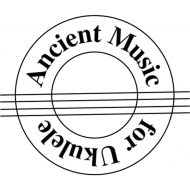Notes on the Arrangements
These arrangements are adapted from corresponding classical guitar arrangements by Murray Visscher that are used with his permission.
For best performance, these types of ukuleles are recommended:
- Ukuleles 1 and 2 – soprano, concert or tenor ukulele in standard tuning as g-C-E-A (i.e. re-entrant tuning using a high G tuning for the fourth string)
- Ukulele 3 – tenor ukulele with linear tuning as G-C-E-A (i.e. using a low G for the fourth string)
- Ukulele 4 – baritone ukulele with standard tuning as D-G-B-E
Note that music for Ukulele 4 has been written up an octave (indicated by the small number 8 under the treble clef sign) for convenience. This is similar to the way music is notated for classical guitar.
Alternatively, Ukulele parts 1, 2 and 3 can be played using Renaissance guitars or classical guitars with capo on the 5th fret and Ukulele part 4 can be played on a classical guitar.
Modern musical notation is used in this book, including suggested tempo markings. Players in the Renaissance would have been expended to know how to play these pieces “properly”, including where to insert ornaments such as trills, grace notes or strums. Only some phrasing and dynamic markings are included with these pieces as few, if any, were included in the original scores.
The pieces have been separated into musical phrases (indicated with double bar lines). These phrases can be repeated to extend the shorter pieces (suggested repeats have been inserted for Pavan #6).
The keys signatures used are for the ease of the modern ukulele player and have been changed to better fit the musical range of the ukulele. Also, some passages have been simplified, including using different bass lines or notes, as this is a book about enjoying the music for amateur players rather than a rigorous adherence to the music at a professional level.
Playing in a Quartet
Preparing your part in advance of playing as a quartet is essential. Get to know your part well so as not to be led astray by other performers in the group. Practicing with a metronome is highly recommended.
The group should be seated in a semi-circle so that each player can hear and interact with the other players. Usually, the first part is on the left and fourth part is on the right when looking at the group from the audience. The chairs/stands should be such that the people can see each other but also allows the audience to see the players. Fronts of the ukuleles should face the audience and stands should be low so that the music can flow over them. Memorizing the music and playing without stands is not essential.
One of the players may act as the “conductor” to set the tempo for the group (they do so after making eye contact with each player which indicates their readiness to start) and to signal the end of the piece (i.e. when to stop playing and finally mute your strings).
When performing as a quartet, the group will continue to play their parts even if you make a mistake or lose your place in the music. Stopping and re-joining the music in progress is a good skill to develop. Knowing what the other parts are playing will help.
The group may “reset” after a section or phrase is completed. The players need to communicate with each other (besides listening and counting) by periodically looking at each other for signals. One member may indicate the start of the next section or phrase with a head nod or an audible inhaled sniff of air.
The group needs to sound well together. The parts should be balanced in volume and style. If you have a key part or scale passage, then standing out from the group makes the music more interesting. However, if you are playing a supporting passage, then you have to be quieter and let the other parts have their moment in the spotlight.
Notes on the Composer
All sources are Wikipedia.
Luis de Milan (c. 1500 – c. 1561) was a Spanish Renaissance composer, vihuelist, and writer on music. He was the first composer in history to publish music for the vihuela de mano, an instrument employed primarily in the Iberian peninsula and some of the Italian states during the 15th and 16th centuries, and he was also one of the first musicians to specify verbal tempo indications in his music. He seems to have been employed by the ducal court until around 1538. In 1535 he published his first book, a parlor game with music, entitled El juego de mandar; in the next year he published what was to be his most important book, Libro de música de vihuela de mano intitulado El maestro. This book was dedicated to King John III of Portugal; this dedication, and the existence of six villancicos which Milán wrote in Portuguese, suggest that he may have traveled to that country and spent some time there. The music of Luis Milan is popular with performers on the present-day classical guitar because it can be adapted very easily to their instrument.
